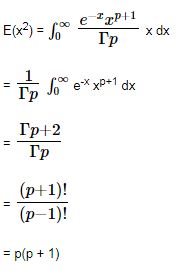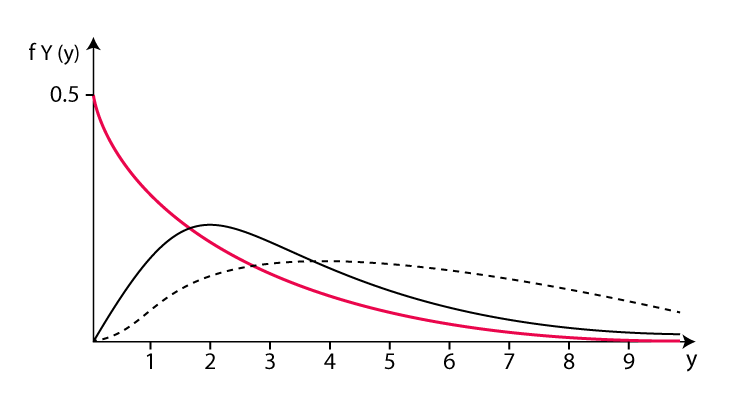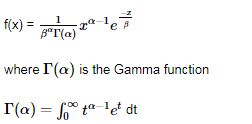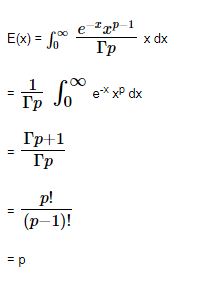Gamma Distribution
Gamma Distribution is one of the distributions, which is widely used in the field of Business, Science and Engineering, in order to model the continuous variable that should have a positive and skewed distribution. Gamma distribution is a kind of statistical distributions which is related to the beta distribution. This distribution arises naturally in which the waiting time between Poisson distributed events are relevant to each other. In this article, we are going to discuss the parameters involved in gamma distribution, its formula, graph, properties, mean, variance with examples.
Table of Contents:
- Definition
- Distribution Function
- Formula
- Graph
- Cumulative Distribution Function
- Properties
- Mean
- Variance
- Example
What is Gamma Distribution?
The gamma distribution term is mostly used as a distribution which is defined as two parameters – shape parameter and inverse scale parameter, having continuous probability distributions. It is related to the normal distribution, exponential distribution, chi-squared distribution and Erlang distribution. ‘Γ’ denotes the gamma function.
Gamma distributions have two free parameters, named as alpha (α) and beta (β), where;
- α = Shape parameter
- β = Rate parameter (the reciprocal of the scale parameter)
It is characterized by mean µ=αβ and variance σ2=αβ2
The scale parameter β is used only to scale the distribution. This can be understood by remarking that wherever the random variable x appears in the probability density, then it is divided by β. Since the scale parameter provides the dimensional data, it is seldom useful to work with the “standard” gamma distribution, i.e., with β = 1.
Gamma Distribution Function
The gamma function is represented by Γ(y) which is an extended form of factorial function to complex numbers(real). So, if n∈{1,2,3,…}, then Γ(y)=(n-1)!
If α is a positive real number, then Γ(α) is defined as
- Γ(α) = 0∫∞ ( ya-1e-y dy) , for α > 0.
- If α = 1, Γ(1) =0∫∞ (e-y dy) = 1
- If we change the variable to y = λz, we can use this definition for gamma distribution: Γ(α) = 0∫∞ ya-1 eλy dy where α, λ >0.

Gamma Distribution Formula
 ,
,
where p and x are a continuous random variable.
Gamma Distribution Graph
The parameters of the gamma distribution define the shape of the graph. Shape parameter α and rate parameter β are both greater than 1.
- When α = 1, this becomes the exponential distribution
- When β = 1 this becomes the standard gamma distribution
Gamma Distribution of Cumulative Distribution Function
The cumulative distribution function of a Gamma distribution is as shown below:
Gamma Distribution Properties
The properties of the gamma distribution are:
For any +ve real number α,
- Γ(α) = 0∫∞ ( ya-1e-y dy) , for α > 0.
- 0∫∞ ya-1 eλy dy = Γ(α)/λa, for λ >0.
- Γ(α +1)=α Γ(α)
- Γ(m)=(m-1)!, for m = 1,2,3 …;
- Γ(½) = √π
Gamma Distribution Mean
There are two ways to determine the gamma distribution mean
- Directly
- Expanding the moment generation function
It is also known as the Expected value of Gamma Distribution.
Gamma Distribution Variance
It can be shown as follows:

So, Variance = E[x2] – [E(x2)], where p = (E(x)) (Mean and Variance p(p+1) – p2 = p
Gamma Distribution Example
Imagine you are solving difficult Maths theorems and you expect to solve one every 1/2 hour. Compute the probability that you will have to wait between 2 to 4 hours before you solve four of them.
One theorem every 1/2 hour means we would suppose to get θ = 1 / 0.5 = 2 theorem every hour on average. Using θ = 2 and k = 4, Now we can calculate it as follows:
\(P(2\leq X\leq 4)= \sum_{x=2}^{4}\frac{x^{4-1}e^{-x/2}}{\Gamma(4)2^{4}} = 0.12388\)To learn more about distributions, visit BYJU’S – The Learning App and learn with ease.


